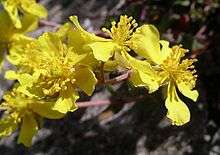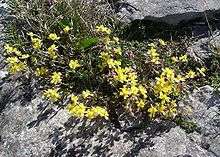Helianthemum oelandicum
Helianthemum oelandicum, commonly called hoary rockrose, is a low growing plant confined to rocky dry calcareous areas especially close to the sea.
| Helianthemum oelandicum | |
|---|---|
 | |
| Helianthemum canum | |
| Scientific classification | |
| Kingdom: | Plantae |
| Clade: | Tracheophytes |
| Clade: | Angiosperms |
| Clade: | Eudicots |
| Clade: | Rosids |
| Order: | Malvales |
| Family: | Cistaceae |
| Genus: | Helianthemum |
| Species: | H. oelandicum |
| Binomial name | |
| Helianthemum oelandicum DC & Lamarck[1] | |
Description

The plant typically has a central stock from which numerous branches radiate horizontally or ascending. Stipules are absent and the small leaves (about 10mm long) are simple and green above but densely hairy and grey below which is a distinguishing characteristic in areas where H. nummularium is also present.[2]
The yellow flowers have 5 petals, free at the base and 5 sepals in cymes generally with 1 to 6 flowers in each cyme.[2]
Habitat
It is restricted to dry limestone rocky areas. In Britain it is always close to the sea but in mainland Europe its range is restricted to the calcareous upland ranges such as the Alps.[3]
Distribution
It occurs in several areas of Europe including France, Germany, Spain, Sweden and parts of north Africa and the eastern Mediterranean countries. In the British Isles it is very restricted in its distribution being limited to parts of the South Wales coastline and a few locations on Anglesey and the Great Orme.[4]
References
- "IPNI".
- Stace C (2005). New Flora of the British Isles (second ed.). Cambridge University Press. p. 218. ISBN 0521427932.
- "Helianthemum oelandicum". Kew Science - Plants of the World Online. 2016. Retrieved 6 June 2017.
- Preston C. D.; Pearman D. A.; Dines T. D. (2003). New Atlas of the British and Irish Flora. Oxford University Press. ISBN 0198510675.